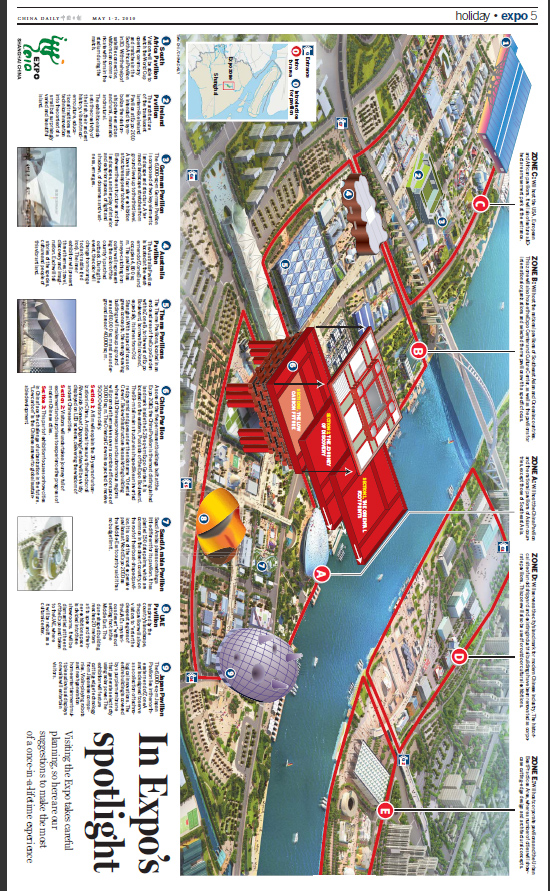

Visiting the Expo takes careful planning, so here are our suggestions to make the most of a once-in-a-lifetime experience
Zone C: Will host the USA, European and African pavilions. It will also feature a 10-hectare amusement park at the entrance.
Zone B: Will host the national pavilions of Southeast Asian and Oceania countries. This zone will also house the Expo Center and Culture Center, as well as the pavilions for international organizations and selected theme pavilions with a specific focus.
Zone A: Will host the China Pavilion and the national pavilions of Asian countries, except those of Southeast Asia.
|
 |
Zone E: Will host corporate pavilions and the Urban Best Practices Area, where a number of cities will showcase cutting-edge design and architectural concepts.
1.South Africa Pavilion
Visitors will be able to watch the World Cup opening ceremony and matches in the South Africa Pavilion in 3D. With the help of satellite connection, visitors can communicate with fans in the stadium during the match.
2.Ireland Pavilion
The architecture of the translucent lantern-like Ireland Pavilion at Expo 2010 is intended to symbolize the relationship between urban and rural, manmade and natural.
The exhibition inside sets the creativity of the Irish, their ancient history, vibrant modern culture, educational traditions and technical innovation into the context of a small but surprisingly varied and beautiful island.
3.German Pavilion
The 6,000-sq-m German Pavilion is composed of two key elements: landscape and structure. A terraced landscape stretches from ground level up to the third level. Above this, four silver exhibition structures appear to hover. Between these structures and the landscapes, an interplay of interior and exterior spaces, of light and shadows, of closeness and vastness, emerges.
4.Australia Pavilion
The Australia Pavilion is located at the western end of Zone B and occupies 4,800 sq m. The pavilion has an eye-catching iron outer wall representing the color of the country's parched outback. During the event, the color will change from orange to dark raddle (red iron). The inner exhibition will present three themes: travel, discovery and imagination. Each will tell stories of the species, culture and people of this vibrant land.
5.Theme Pavilions
The Theme Pavilions, located in an enclosed area of the Expo Garden within Zone B, to the west of Expo Boulevard, borrows its look and, especially, its lanes from Old Shanghai. With a special focus on green concepts, the energy-saving buildings will make up a ground area of 80,000 sq m and an underground area of 40,000 sq m.
6.China Pavilion
As one of the five permanent buildings built at the Expo 2010, the China Pavilion is the most distinguished landmark inside the 5.28-sq-km Expo Garden. It is located on the eastern, Puxi side of the Expo Boulevard. The 69-m tall main structure is shaped like an inverted red pyramid and goes under the nickname "Oriental Crown". Below this structure lies a skirting building where 31 Chinese provinces and autonomous regions will promote themselves over a combined floor space of 30,000 sq m. The Oriental Crown is expected to receive 50,000 visitors daily.
Section 1: A film will explain the 30 years of urbanization in China. A national treasure, the handscroll Riverside Scene at Qingming Festival will be vividly displayed on LED screens, delivering the wisdom of ancient Chinese cities.
Section 2: Visitors will undertake a journey full of excitement and surprises to experience the progress of modern Chinese cities.
Section 3: This part of exhibition focuses on how cities in China face the challenge of urbanization in the future. "Low carbon" is the Chinese answer to global sustainable development.
7.Saudi Arabia Pavilion
Saudi Arabia plans something a little different for its pavilion. It has planted 150 date palms, which are common in the desert country, on the roof of their boat-shaped pavilion. It is one of the most expensive pavilions at World Expo 2010 as the Middle-East country said it has no budget limit.
8.UAE Pavilion
Inspired by the country's landscape, the pavilion will allow visitors to "enter the deepest regions of the UAE's mysterious desert" without setting foot in the Middle East. The dune-shaped building reaches 20 meters at its apex and the inner-exhibition space is divided into three showrooms. It will be dismantled at the end of the Expo and taken to the UAE, where it will be rebuilt as a cultural center.
9.Japan Pavilion
The 6,000-sq-m Japan Pavilion lies in the northeastern end of Zone A and is designed to serve as a collection of technological innovations. The entire building is covered by a purple membrane that generates electricity using solar power. The exhibition will feature cutting-edge technology from Japanese companies. Violin-playing robots and next-generation home entertainment multiple audiovisual displays on walls will entertain visitors.
(China Daily 05/01/2010 page29)
